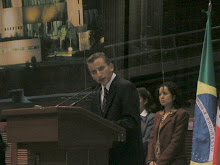The second half of The President is the most interesting part that I have read in years! Its dramatization and the way in which the story is presented kept my attention for a lot of time and it was no difficult to finish the book. Now I can understand the functions of all the characters that Asturias used and the importance that they have in the development of the book.
I think that the essential part of the book is the story of Angel Face, and as a background we have examples of the practices that the dictator has in order to follow his own wishes. I am impressed of how the net among all the characters has the same direction and how Asturias used all the characters as tools to describe the government.
In this kind of government you have to be careful always, it is difficult to understand why Angel Face didn’t realize the president’s plan. The entire story has the same way. When Canales was blamed when he was innocent, I didn’t understand why, but with the president’s reaction after the Camila’s wedding, it is obvious that the president was in love with Camila. Therefore, I don’t know why Angel Face was thinking that it won’t be a problem to travel to the US.
Why the reference of the US? Perhaps Asturias used this reference to express freedom; Angel Face would have freedom if he went to the United States? It is interesting, because Asturias never mention that he was talking about Venezuela, but at the same time, he mentioned as a reference of freedom the US.
The story is developed in a period short period of time (a week), It seems that Asturias want to express that these practices are very common, as a routine in the government. It was no difficult for the president or for the war minister to do the entire things that they did and it was normal for the system.
The Asturias style is really amazing, the surrealistic tools that he used to make the president’s image, his stylistic resources and the way in which he make his descriptions among the book made me feel like if I was inside the story. It was no difficult to read and, instead of that, all the comparisons and the metaphors that he used help me to imagine all the psychological situations that were involved in the book.
Subscribe to:
Post Comments (Atom)

6 comments:
I think your comment that the President was probably in love with Camila, is very interesting and had not thought of it like that. It makes a bit more sense as to why the President would want General Canales gone, but if Canales was originally on the President's side would he really have said no to him having his daughter? Can anyone really say no to the President?
I agree that there is a lot of focus on Angel Face, he seems to be the main character and all the drama unfolds all around him.
When Asturias mentioned that Angel Face was headed to the US, (which I also think symbolised some sort of freedom) I had a feeling it was not gonna happen.
I think your comment about Camilla and the President being in love with her makes a lot of sense. I was wondering why the President would choose to break Angel Face's heart by planting someone in the prison to tell him that Camilla had become a mistress to the President because Angel Face had abandonned her, but it makes sense if the President really was in love with her.
I also think your cooment about the President wanting Camilla for himself is interesting and I agree to a large extent...he probably had hi seye on her. But, I also think that it does not really matter whether or not he actually loves her...The point is the total defeat and humiliation of Angel Face...the victory of having 'won over' his wife, of having convinced her that she was abandoned by her husband.
I agree how you enjoy Asturias' style and surrealistic imagery. It does keep things lively and provokes interest. I have not yet finished the book, but without giving everything away you managed to incite some curiousity for me. Thanks
I also wondered about the connection between the United States and the country where events of this book are taking place. There are actually quite a few locations in Latin America which are comparable. However, the clues still point towards somewhere in Central America (probably Guatemala). The connection between the countries is necessary however, due to previous US support of many of these regimes through the School of the Americas and other such funding.
Post a Comment